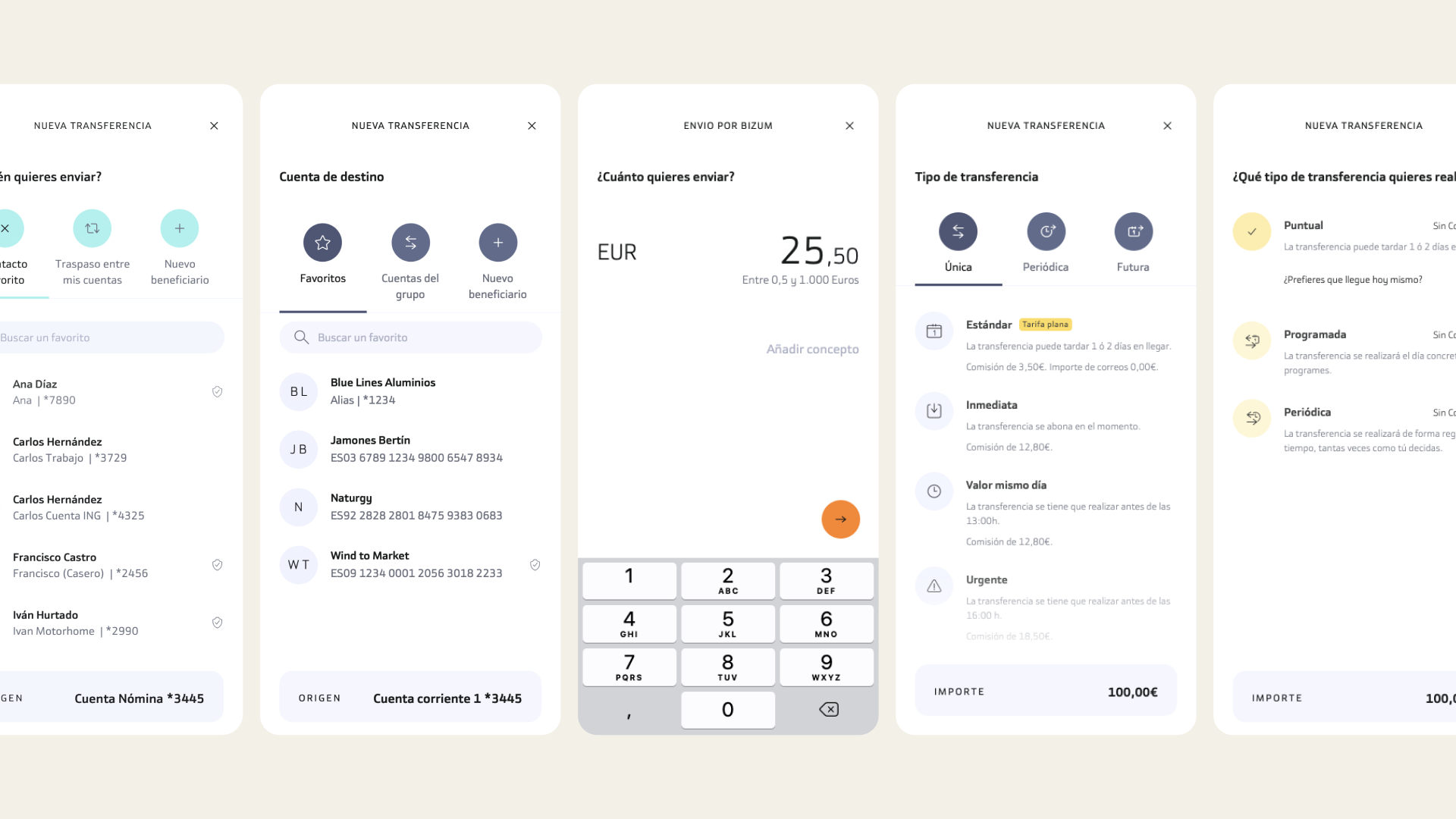Bankinter
Streamlining bank transfers for enhanced user experience
Skills
Data Analysis, UX Research, Product Design, Design Systems, Team Leadership
PROCESS
Analize the internal flows
Analize competitors flows
Define the user experience
Prototype the main flows for stakeholders aligning and user testing
Contribute to the Design System
TEAM & Collaboration
Cross-functional teamwork, including UX Research team, Product Managers of the different tribes, Stakeholders to ensure a cohesive and user-centered redesign.
⎯ Designing for complexity: A unified transfers experience across platforms and segments
As part of Bankinter’s rebranding initiative, I led the redesign of one of its most critical and high-traffic features: bank transfers. Beyond refreshing the look and feel, this project was an opportunity to rethink the experience for individuals and corporations, across both web and mobile platforms.
My goal was to bring clarity, consistency, and efficiency to a complex feature used by diverse audiences—from people sending rent or holiday gifts, to companies managing recurring payrolls. By breaking down the challenges into targeted user flows, aligning with cross-functional teams, and iterating based on research insights and usability testing, I designed a solution that scaled seamlessly and drove meaningful improvements.
highlights
Defined the core flows and interaction logic, enabling cross-platform scalability and handoff to 4 product teams to complete and implement the full experience.
Contributed new components and patterns to the design system, making the solution adaptable for both complex corporate transfers and lightweight flows like P2P Bizum.
Boosted performance and usability, with a 43% reduction in time on task and an 80% increase in task success rate after usability testing and refinement.
⎯ Shaping the right concept to validate the right problem
To ensure no use case was left behind, I started by mapping out all existing transfer flows—covering everything from one-off payments to complex corporate transfers with multiple approvals. This comprehensive mapping allowed us to spot overlaps, inconsistencies, and high-frequency paths across user types.
From there, I developed two core prototype flows—one tailored to individuals, the other to corporate users. These represented the most common behaviors: sending recurring transfers to a preferred contact, or scheduling with pending authorization.
The prototype became a strategic alignment tool, helping stakeholders from product, business, and tech see how their specific concerns were addressed. Each team needed their perspective represented before giving sign-off, and the prototype made those discussions tangible and efficient. It also formed the foundation for usability testing.
Partnering with UX Research, we validated the flows early on. Feedback confirmed we were solving the right problems, and only minor copy adjustments were needed. With a strong concept in place, product teams were able to confidently scale the solution across all cases.
⎯ Design once, scale everywhere
The redesigned transfer flow set a flexible foundation that scaled effortlessly across use cases. For corporate transfers, we preserved simplicity while accommodating added complexity like batch payments and approval steps. On the other end, adapting it for lighter flows like Bizum’s P2P payments was just as smooth. This approach didn’t just solve one problem—it shaped a reusable layout model that became part of our design system, ready to adapt to any level of complexity.
What I've learned
A solid concept unlocks alignment.
Spending time upfront to define and prototype the core flows created a shared reference point for all stakeholders. It helped streamline discussions, uncover blind spots early, and enabled faster, more confident decisions down the line.
Design doesn’t stop at handoff.
Even after handoff, I realized the importance of staying close to implementation. Tracking changes across platforms, analyzing the impact of updates, and safeguarding consistency is essential to ensure the original vision scales without dilution.
Scalability starts with structure.
By designing flexible, modular patterns, we were able to scale up for complex corporate use cases and downsize for lightweight flows like Bizum with minimal effort. That structure became a key contribution to the design system, saving time and aligning future work.
If you reach this far,
maybe you're interested in saying hi.
© 2025 Diana Morgado · All rights reserved
© 2025 Diana Morgado · All rights reserved
© 2025 Diana Morgado · All rights reserved

